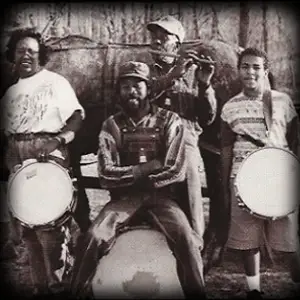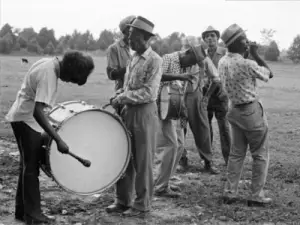FIFE & DRUM MUSIC
 Fife and drum music is a branch of country Blues that has survived from the 19th Century in a few remote rural districts of northern Mississippi. With modest home-made instruments and a simple structure, it is neverthless a joyful music, made for dancing and sharing with friends and neighbours, from a time when time itself was the only luxury. Like many kinds of folk music, it incorporates a wide range of influences, picking up nuances from all over the place.
Fife and drum music is a branch of country Blues that has survived from the 19th Century in a few remote rural districts of northern Mississippi. With modest home-made instruments and a simple structure, it is neverthless a joyful music, made for dancing and sharing with friends and neighbours, from a time when time itself was the only luxury. Like many kinds of folk music, it incorporates a wide range of influences, picking up nuances from all over the place.
One known source of fife and drum music is the European military. The two instruments were used together to synchronise marching and lighten the spirits of the troops by the Swiss Army in the 1400s, and later taken up by their French and German neighbours. While hardly deserving the title ‘talking drums’ they could be used to convey signals, such as turns, formations and halts, and could be heard over long distances. When Britain acquired a line of German monarchs in 1715, they introduced the fife and drum to their Armies, except for the Scottish regiments who persisted with their ear-torturing and terrifying bagpipes! These practices were transferred to the American colonies, where Native Americans and African Americans could only enlist as musicians or ‘pioneers’. During the Revolutionary War, almost every Company on both sides would use the fife and drum. It was deeply embedded in Military practice, and during the Civil War, on the Confederate side there were some instances of slave musicians performing the duty.
Hootin’ an’ hollerin’ with a Fife & Drum band;
During the Reconstruction of the late 1800s, African Americans felt able to incorporate traditional African elements into their culture. Religious practice and folk music began to change with this new freedom, with the rise of ‘Spirituals’ and the growth of localised folk music traditions, which in the Mississippi Delta would gave rise to The Blues at the turn of the 20th Century. However, up in the hill country of North-east Mississippi, towards Tennessee, fife and drum music found a new home and some new input. Heavy syncopation and polyrhythmic patterns with distinct African roots were incorporated into the drums. A ‘talking drum’ has the beats correspond to the syllables in speech, and with two snares and a bass drum, they could talk across each other. The cane-flute is an almost universal instrument, easily made from handy materials, and the five or six-hole fife is generally used. Some players prefer the ‘quills’, a four or up to ten-hole pan-pipe which is also well known in North Africa, but a flute is so easy to make, a player might have several, each with a with different pitch.
 Regarding melodies, there is some affinity with Irish ‘penny whistle’ music, perhaps from the ‘Hillbillies’ a little further East, as that name was applied to Irish protestant supporters of William of Orange (King Billy) who had fled religious trouble back home, and brought their music with them. Popular songs, Ethiopian tunes (as Minstrel songs were often called), Ragtime ditties and even waltzes were incorporated into the repertoire. There is input from religious music too, although fife and drum music was never played in Church and not allowed on Sundays, and sessions would almost always end with a hymn. Vocal parts often consist of a single repeated phrase, although there can be a lot of moaning and humming too, but Blues songs like ‘Sitting on Top of the World’ and ‘My Babe’ sound great played by a fife and drum band.
Regarding melodies, there is some affinity with Irish ‘penny whistle’ music, perhaps from the ‘Hillbillies’ a little further East, as that name was applied to Irish protestant supporters of William of Orange (King Billy) who had fled religious trouble back home, and brought their music with them. Popular songs, Ethiopian tunes (as Minstrel songs were often called), Ragtime ditties and even waltzes were incorporated into the repertoire. There is input from religious music too, although fife and drum music was never played in Church and not allowed on Sundays, and sessions would almost always end with a hymn. Vocal parts often consist of a single repeated phrase, although there can be a lot of moaning and humming too, but Blues songs like ‘Sitting on Top of the World’ and ‘My Babe’ sound great played by a fife and drum band.
Luther Dickinson and the great Otha Turner play ‘My Babe’;
Dancing is integral to this music, and the band is always on the move. It is called marching (perhaps from its military origins), but they don’t cover much ground, preferring a kind of two-step shuffle or just swaying to the rhythm. It does inspire some energetic dancing among others, with tap, buck and hambone variations, with the exuberant ‘patting Juba’ showing its distinctly African roots. This party music was an important part of neighbourhood life in North Mississippi, with picnics, Independence Day, Labor Day and almost any other day an excuse for a celebration.
This joyful music was first heard outside its community in 1942 when Alan Lomax recorded the fife of Sid Hemphill and drummer Lucius Smith in Tate County. Sid’s grand-daughter, Jessie Mae later became a noted boogie-playing Blueswoman, but she often found time to play drums in his band. Lomax returned to the area in the late 50s, where he recorded Ed and Lonnie Young, but those sessions were somewhat overshadowed by his ‘discovery’ of Mississippi Fred McDowell at the same time. Dave Evans and George Mitchell, two serious students of country Blues music, recorded more fife and drum bands around the same area in the late 60s and 70s. Other outposts were discovered by Dave and George in rural communities in Tennessee, Georgia and Missouri, but traditional culture is a fragile thing, easily lost in the modern world. Ed and Lonnie Young are remembered for their song ‘Chevrolet’ but it became obvious as the century drew to a close that the ‘old hands’ were not going to last forever. Napoleon Strickland, a multi-instrumental fife and drum master, taught by Otha Turner himself, passed away in 2001, there were precious few left. When 95-year-old Otha passed away a couple of years later, a legend left us, but his nephew RL Boyce and his grandchildren, especially Shardé Thomas, keep the music alive.